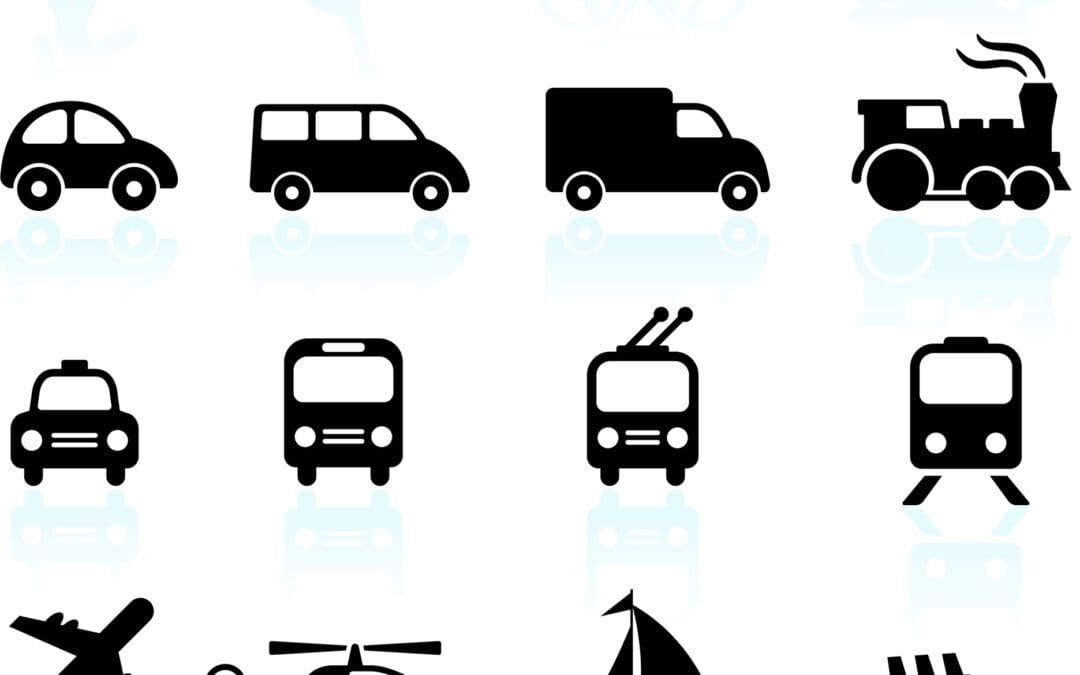There are pros and cons for the different forms of transportation people use every day. The choice of how to get to work or school, run errands, or take longer trips often depends on what modes are available. In densely populated cities, bikes, walking, and public transit rule. In rural areas, cars, trucks, and motorcycles are the only realistic way to get around.
The best strategy is to weigh the safety-related pros and cons of each mode of transport and then find ways to minimize any risks. Here is an outlook of safety associated with the most common forms of transport.
Cars and Trucks
Car safety has improved from 1972, when an all-time high of 56,278 people died in vehicle accidents. However, the number of fatalities has risen since 2010, reaching 46,980 in 2021.
Factors like increased speeds, more distractions, more vehicles on the road, and an overreliance on accident avoidance systems have all contributed to this rise in fatalities. Despite this, people still use cars and trucks as one of the most popular modes of transportation today — and for good reason.
Pros
Cars are reasonably safe, especially with new vehicle safety-related technology. Driver assistance tools like electronic stability control join established features like anti-lock brakes to help avoid accidents.
That being said, some vehicles are safer than others, and you can distinguish which ones are best through safety ratings published by the National Highway Transportation Safety Administration.
Drivers can also increase their level of safety by using defensive driving practices. If you do experience an accident, the legal system has a clear process for getting a settlement to cover injury and other costs.
Cons
Even the best defensive drivers can get in accidents, as cars and trucks have the highest injury and fatality numbers of any mode of transport.
Bad driving habits and new problems combine to keep risks high on American roads. For instance, speed still accounts for one-third of all traffic deaths and leads to serious incidents, like T-bone accidents. Also, instead of obeying limits and paying closer attention to the road, many drivers rely too heavily on new automated systems to avoid accidents.
Even less serious accidents, such as getting rear-ended, can still lead to expensive repairs or injuries like whiplash or a concussion.
You can file an accident lawsuit to seek compensation if the at-fault driver or their insurance doesn’t pay.
Motorcycles
In 2021, there were 60 fatalities per 100,000 motorcycles involving motorcycles. The rate for cars was 12.5, meaning motorcyclists were nearly five times more likely to die in a crash than those in passenger vehicles.
Ironically, a majority of accidents involve collisions with other vehicles. If a driver causes an accident with your bike, they are liable to pay damages.
Even with these documented risks, motorcycles are still very popular, with 8.6 million personal motorcycles registered in the US.
Pros
Motorcycles are easier to navigate in traffic and tight spaces because of their smaller size. With the proper equipment, motorcyclists can increase their safety. For instance, helmets can lower the risk of a brain injury by 74%.
They can also take advantage of new technology, such as anti-lock braking systems, adaptive headlines, and automatic transmissions, to operate their bikes with ease in emergencies.
Cons
The reputation of motorcycles as dangerous vehicles is partially deserved. Riders do not have the same protections, such as airbags and steel frames, that cars offer.
Since motorcycles are naturally smaller than most other vehicles, they’re less visible and more likely to slip into other drivers’ blind spots.
Finally, motorcycles are less stable than cars, reducing the ability to recover from swerving or oversteering. Even minor mistakes could lead to a biker falling and sliding across the pavement.
Trains and Light Rail
Trains and light-rail systems are common in urban centers as they are often practical, with low-cost fares offering cheaper commutes than cars. Train passengers do not have to worry about driving, parking, gas prices, accidents, or other vehicle ownership and operation concerns.
However, trains and light rail systems, which run next to or on roadways, have a different set of safety concerns.
Pros
When available, trains are a reasonably safe mode of transportation as far as accidents and crashes are concerned due to the following features:
- Extensive safety features and redundancies to avoid accidents from human error.
- Protected tracks eliminate the chance of collisions with vehicles.
In addition, CCTV cameras, law enforcement, and security officials ensure safety around trains as well.
Cons
However, crime is a problem on crowded trains. For instance, New York City has seen a rise in assaults on its subway system.
The COVID-19 pandemic also demonstrated the risk of virus or disease transmission on crowded trains.
In addition, you always have to take another, potentially dangerous, form of transport, such as walking, bike, or bus, to get to a train station.
Buses
Buses are a common public transit option. They are cost-effective and available for commutes and long-distance travel. More cities and towns have buses than rail lines because buses can run on existing roads and do not require expensive infrastructure upgrades.
In many cities and towns, buses serve as the only form of mass transit, so people need to be aware of their benefits and drawbacks.
Pros
Buses have professional drivers who have the training and skills to handle conditions and situations better than personal vehicle drivers.
Also, many jurisdictions have maintenance standards that buses need to meet to remain in operation. This extra attention means mechanical failures are less likely.
Cons
Personal security can be an issue on buses. In some cities, crime and harassment are common. Also, buses use public roads and have to deal with poor driving conditions and traffic which can increase the risk of bus accidents.
Finally, most buses lack safety features like airbags and seatbelts. In a high-speed accident or collision with another large vehicle, passengers lack basic protections.
Taxis and Rideshares
Rideshare services like Uber and Lyft have become more common in recent years, with 30% of Americans saying they use rideshare services in a pre-pandemic survey. Uber and Lyft can increase safety in certain instances, but they also present new dangers.
Pros
Rideshare services can help you avoid specific dangerous situations, such as driving under the influence or when overly fatigued. They can also reduce dangers associated with parking and walking to vehicles by dropping you off right at your destination.
Finally, drivers need to undergo background checks and vehicle inspections, which can alert the companies to potential issues before the driver starts working.
Cons
Even though driver and vehicle checks are necessary, the standards are not as strict as for public transit operators. This can lead to issues like sexual assault and robberies, which sometimes occur in rideshare vehicles. Also, poor rideshare drivers have the same high risk of a car accident as bad personal vehicle drivers.
Rideshare and taxi drivers are required to have insurance, so you can usually settle an accident in an Uber or other rideshare vehicle.
Bicycles
More than 600,000 people commuted by bike in 2021. This popular and eco-friendly mode of travel allows you to combine transportation with exercise and get joy out of your commute.
For cyclists, safety issues can vary widely depending on conditions, routes, and local drivers’ ability to share the road.
Pros
Bikes can be safe because they can use sidewalks, paths, and trails to avoid vehicles and decrease the risk of accidents. Bicycle safety gear like helmets and pads can offer further protection, while lights and reflectors can increase visibility.
Bikers can further decrease risks by choosing routes that go around busy streets or follow roads with dedicated bike lanes separate from vehicle traffic.
Cons
On streets, car drivers may not be looking for bikes. Most serious accidents involve cars not seeing bikes until it’s too late. When these incidents happen, they can lead to significant injuries for cyclists, even if they are wearing protection. Also, bicyclists are exposed to the elements, which can create weather-related dangers and increase the risk of crime.
Walking
Walking is the most cost-effective means of transport, though it is not always practical for commuting in cities that have more highways or expansive cityscapes. Safety issues can vary depending on where you walk.
Pros
Most cities and towns have dedicated pedestrian areas where you can walk without crossing traffic. At road crossings, markings, signs, and traffic lights can halt traffic so walkers can get to the other side safely.
Walkers have flexibility, as well. Since you can choose where you walk and do not need to stay on a road or path, you can easily walk around obstacles and potentially dangerous situations.
Cons
Pedestrian accidents are surprisingly common. Nearly 8,000 walkers died in collisions in 2021. Most of these happen in areas without pedestrian infrastructure and at night. Because they lack the protection of steel-enforced vehicles or safety equipment, walkers have a much higher risk of injury in any collision.
Drivers are often liable or partly responsible for pedestrian accidents. If you were hit while walking, you can file a claim to attempt to pursue a settlement payout.
Planes
For long-distance travel, airplanes offer the ideal blend of speed and safety. You can reach the other side of the world in under a day on airplanes. Convenience is the primary reason why there were 751 million commercial plane boardings in the U.S. in 2022.
Pros
In terms of accidents and fatalities, airplanes are the safest form of transport. The aviation industry is highly regulated, with stringent safety standards enforced by authorities like the Federal Aviation Administration (FAA). Commercial planes are equipped with state-of-the-art technology and redundancies that correct pilot or control tower errors. There have only been two fatalities on scheduled commercial flights in the U.S. since 2010.
Cons
Planes are not without dangers. Even if you do not crash, you could experience an injury or illness. For instance, health concerns are always an issue. Recent outbreaks, such as COVID and SARS, harmed people flying with infected passengers.
Ferries
Ferry service can differ by location. These vessels can cross rivers, lakes, seas, or oceans. Some carry vehicles, while others are only for pedestrian passengers. In cities, ferries can serve as an alternative to road travel. While longer-distance services can replace more expensive flights or highways that go around large bodies of water.
Pros
Ferries typically have well-trained staff and captains. If an accident happens, the boats have floatation devices, guard rails, and rescue plans. Also, many ferries are much larger than other boats on the waterways, so these vessels give them the right of way.
Cons
Since ferry standards are not uniform, you need to consider some of the potential drawbacks. For instance, weather conditions can pose safety challenges and increase the risk of an accident. Like other forms of public transit, virus transmission, petty crime, or overcrowding are issues on ferries.
With all this information in mind, you can select the mode of transportation that fits your needs and gives you the best opportunity to reach your destination safely.


